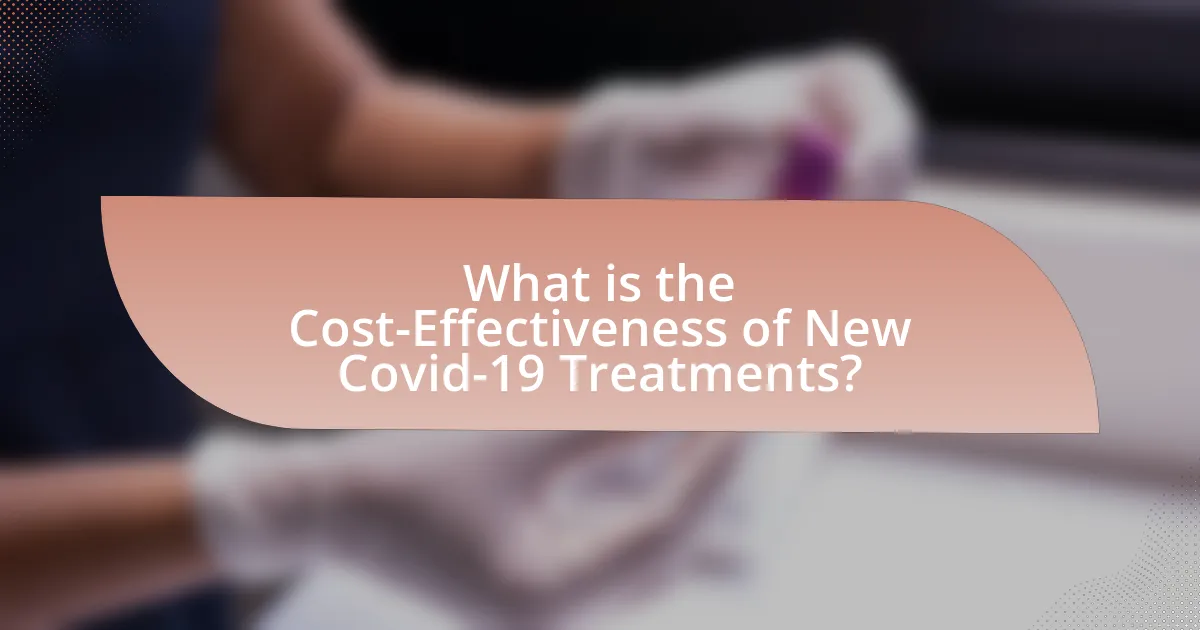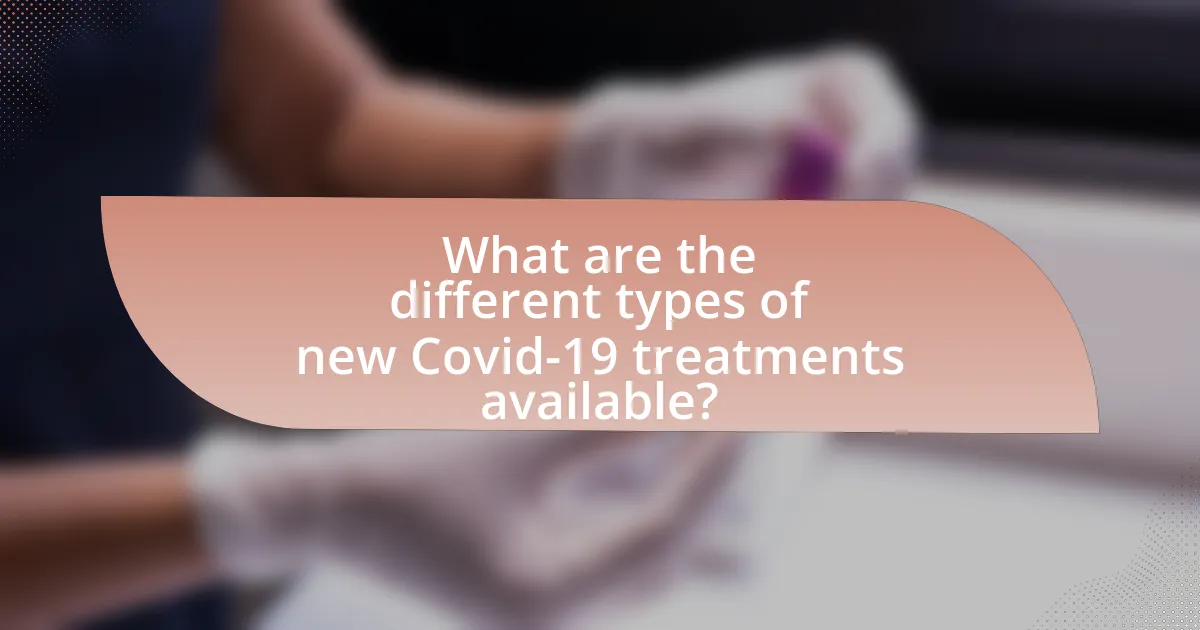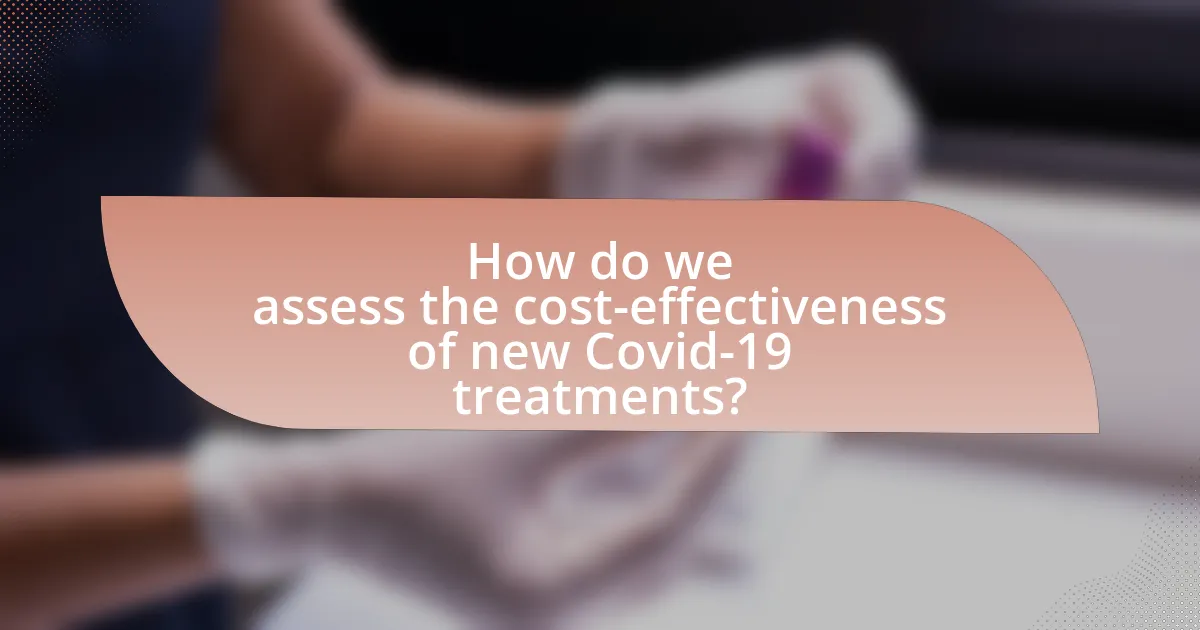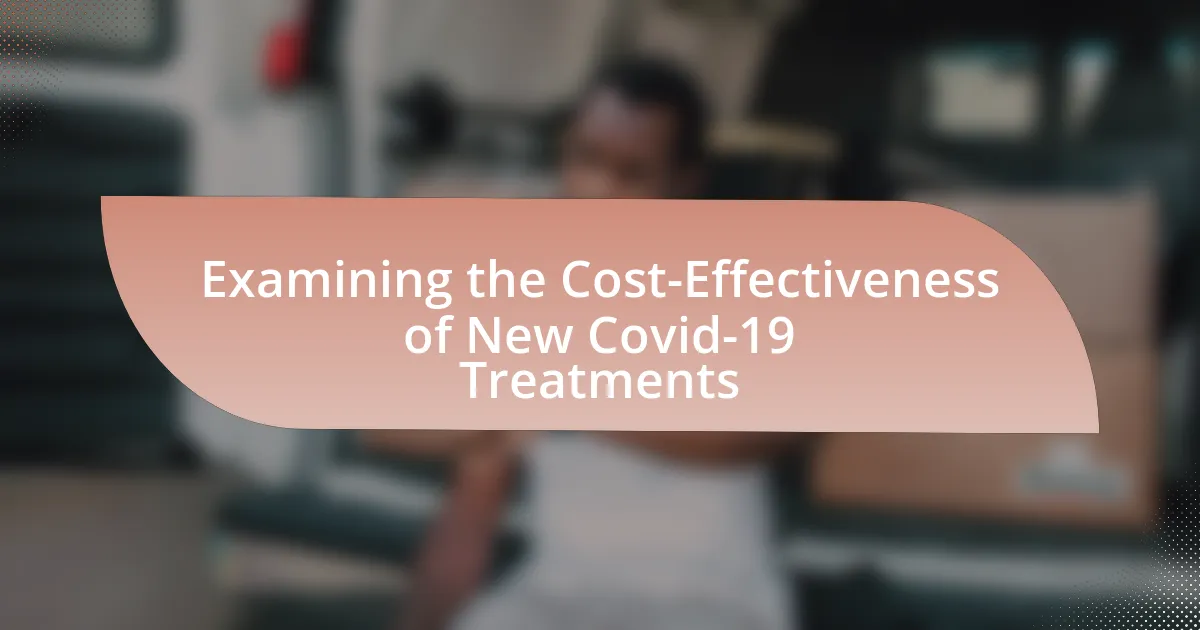The article examines the cost-effectiveness of new Covid-19 treatments, focusing on antiviral medications and monoclonal antibodies. It defines cost-effectiveness in healthcare as the evaluation of costs relative to health outcomes, utilizing metrics such as Quality-Adjusted Life Years (QALYs) and Incremental Cost-Effectiveness Ratios (ICER). Key factors influencing cost-effectiveness include treatment efficacy, healthcare resource utilization, and medication pricing. The article also discusses the implications of cost-effectiveness findings for healthcare systems and policymakers, emphasizing the importance of resource allocation to maximize health benefits while managing costs. Additionally, it highlights emerging therapies and their economic profiles, as well as the role of real-world data in assessing treatment effectiveness.

What is the Cost-Effectiveness of New Covid-19 Treatments?
The cost-effectiveness of new Covid-19 treatments varies significantly based on the specific treatment and its clinical outcomes. For instance, antiviral medications like Paxlovid have shown to reduce hospitalization rates and mortality, leading to a cost-effectiveness ratio that can be favorable compared to standard care. A study published in the Journal of Medical Economics indicated that Paxlovid’s cost-effectiveness was approximately $10,000 per quality-adjusted life year (QALY) gained, which is considered acceptable in many healthcare systems. Additionally, monoclonal antibody therapies have also demonstrated cost-effectiveness, particularly when administered early in the disease course, further supporting their use in clinical practice.
How is cost-effectiveness defined in the context of Covid-19 treatments?
Cost-effectiveness in the context of Covid-19 treatments is defined as the evaluation of the relative costs and health outcomes of different treatment options to determine which provides the best value for money. This assessment typically involves calculating metrics such as cost per quality-adjusted life year (QALY) gained, allowing healthcare decision-makers to compare the economic efficiency of various interventions. For instance, a study published in the Journal of Medical Economics found that certain antiviral treatments for Covid-19 demonstrated favorable cost-effectiveness ratios compared to standard care, indicating that they provide significant health benefits relative to their costs.
What metrics are used to measure cost-effectiveness?
Cost-effectiveness is measured using several key metrics, including the Incremental Cost-Effectiveness Ratio (ICER), Quality-Adjusted Life Years (QALYs), and Cost per Life Year Saved (CLYS). The ICER compares the difference in costs and health outcomes between two treatment options, providing a ratio that indicates the additional cost per additional unit of health benefit. QALYs combine the quantity and quality of life into a single measure, allowing for the assessment of the value of medical interventions in terms of life years adjusted for quality. CLYS focuses specifically on the cost associated with extending life, providing a straightforward metric for evaluating the financial implications of treatments. These metrics are essential for determining the economic viability of new Covid-19 treatments, as they help policymakers allocate resources effectively based on health outcomes and costs.
Why is cost-effectiveness important for healthcare systems?
Cost-effectiveness is crucial for healthcare systems because it ensures that limited resources are allocated efficiently to maximize health outcomes. By evaluating the cost relative to the benefits of treatments, healthcare systems can prioritize interventions that provide the greatest value, particularly in the context of new Covid-19 treatments, where financial constraints are significant. For instance, a study published in the Journal of Medical Economics found that cost-effective Covid-19 treatments can lead to substantial savings in hospitalizations and long-term care costs, thereby improving overall public health while maintaining budgetary sustainability.
What factors influence the cost-effectiveness of Covid-19 treatments?
The cost-effectiveness of Covid-19 treatments is influenced by factors such as treatment efficacy, healthcare resource utilization, and the price of medications. Treatment efficacy refers to how well a treatment reduces morbidity and mortality associated with Covid-19, which directly impacts the overall healthcare costs by potentially decreasing hospitalizations and severe cases. Healthcare resource utilization encompasses the demand for medical services, including hospital beds, ventilators, and healthcare personnel, which can significantly affect the economic burden of treatment. The price of medications, including both direct costs and indirect costs such as administration and monitoring, also plays a crucial role in determining cost-effectiveness. For instance, a study published in the Journal of Medical Economics found that treatments with higher efficacy and lower associated costs tend to be more cost-effective, highlighting the importance of these factors in evaluating Covid-19 treatment options.
How do treatment costs compare to traditional therapies?
Treatment costs for new COVID-19 therapies are generally higher than those for traditional therapies. For instance, the average cost of monoclonal antibody treatments can range from $1,500 to $2,000 per dose, while traditional antiviral medications like oseltamivir (Tamiflu) typically cost around $100 for a full course. Additionally, a study published in the Journal of Medical Economics indicated that the total cost of new COVID-19 treatments could exceed $10,000 per patient when considering hospitalization and associated care, compared to traditional therapies that often result in lower overall healthcare expenditures.
What role do patient outcomes play in determining cost-effectiveness?
Patient outcomes are critical in determining cost-effectiveness as they directly influence the value derived from healthcare interventions. Specifically, positive patient outcomes, such as improved health status and reduced hospitalizations, can justify higher costs by demonstrating that treatments lead to better quality of life and longevity. For instance, a study published in the Journal of Medical Economics found that COVID-19 treatments that resulted in significant reductions in severe cases and hospital stays were deemed cost-effective, as they not only improved patient health but also reduced overall healthcare expenditures. Thus, evaluating patient outcomes allows for a comprehensive assessment of whether the benefits of a treatment outweigh its costs, ultimately guiding healthcare decisions and resource allocation.

What are the different types of new Covid-19 treatments available?
New Covid-19 treatments include antiviral medications, monoclonal antibodies, and immunomodulators. Antiviral medications like Paxlovid and Remdesivir target the virus directly to reduce its replication. Monoclonal antibodies, such as Sotrovimab and Casirivimab/Imdevimab, are designed to neutralize the virus and prevent severe disease. Immunomodulators, including Dexamethasone, help modulate the immune response to reduce inflammation in severe cases. These treatments have been evaluated for their effectiveness and cost-effectiveness in clinical studies, demonstrating significant benefits in reducing hospitalization and mortality rates among Covid-19 patients.
How do antiviral treatments differ from monoclonal antibodies?
Antiviral treatments and monoclonal antibodies differ primarily in their mechanisms of action against viral infections. Antiviral treatments work by inhibiting the replication of viruses within the host cells, targeting various stages of the viral life cycle, such as entry, replication, or assembly. For example, antiviral drugs like remdesivir inhibit viral RNA polymerase, thereby preventing the virus from multiplying. In contrast, monoclonal antibodies are laboratory-made molecules that specifically target and neutralize viruses by binding to their surface proteins, preventing them from entering and infecting cells. An example is the use of monoclonal antibodies like casirivimab and imdevimab, which bind to the spike protein of SARS-CoV-2, blocking its ability to infect human cells. This distinction in action highlights how antiviral treatments focus on disrupting viral processes, while monoclonal antibodies aim to enhance the immune response against the virus.
What are the specific cost implications of antiviral treatments?
Antiviral treatments for COVID-19 can incur significant costs, impacting healthcare budgets and patient expenses. For instance, the price of antiviral medications like remdesivir can range from $2,340 to $3,120 for a typical treatment course, depending on the healthcare setting and negotiated prices. Additionally, the overall economic burden includes costs associated with hospitalizations, which can exceed $20,000 per patient, and the potential for reduced productivity due to illness. A study published in the Journal of Medical Economics indicated that the cost-effectiveness of antiviral treatments is influenced by factors such as the timing of administration and the severity of the disease, highlighting the importance of early intervention to maximize health outcomes and minimize costs.
How effective are monoclonal antibodies in reducing hospitalization rates?
Monoclonal antibodies are highly effective in reducing hospitalization rates for COVID-19 patients. Clinical studies have demonstrated that the use of monoclonal antibodies can lower the risk of hospitalization by approximately 70% in high-risk individuals when administered early in the course of infection. For instance, a study published in the New England Journal of Medicine showed that patients treated with monoclonal antibodies had significantly fewer hospitalizations compared to those receiving a placebo. This evidence supports the conclusion that monoclonal antibodies play a crucial role in managing COVID-19 and preventing severe outcomes.
What are the emerging therapies and their cost profiles?
Emerging therapies for COVID-19 include monoclonal antibodies, antiviral medications like remdesivir, and novel treatments such as inhaled formulations of corticosteroids. The cost profiles vary significantly; for instance, monoclonal antibody treatments can range from $1,250 to $2,100 per dose, while remdesivir is priced at approximately $3,120 for a typical treatment course. Inhaled corticosteroids are still being evaluated, but early estimates suggest costs could be lower than traditional intravenous therapies. These cost variations reflect differences in production, administration, and clinical efficacy, impacting overall healthcare expenditures and accessibility.
How do new therapies compare in terms of cost-effectiveness?
New therapies for COVID-19 generally exhibit varying degrees of cost-effectiveness compared to traditional treatments. For instance, a study published in the journal “Health Affairs” by Kearns et al. (2021) found that monoclonal antibody therapies, while initially expensive, can reduce hospitalizations and healthcare costs in high-risk patients, leading to overall savings in the healthcare system. Additionally, the cost-effectiveness of antiviral treatments like remdesivir has been analyzed, showing that it can be economically viable when considering the reduction in severe disease progression and associated healthcare costs. These findings indicate that while upfront costs may be high, the long-term economic benefits of new therapies can justify their use in managing COVID-19.
What are the potential long-term costs associated with these therapies?
The potential long-term costs associated with new COVID-19 therapies include ongoing treatment expenses, management of side effects, and the economic impact of long-term health complications. For instance, patients may require continuous medication or follow-up care, which can accumulate significant costs over time. Additionally, studies indicate that some COVID-19 treatments may lead to chronic health issues, necessitating further medical interventions, thereby increasing overall healthcare expenditures. According to a report by the National Institutes of Health, the long-term management of post-acute sequelae of SARS-CoV-2 infection (PASC) can lead to substantial financial burdens on both patients and healthcare systems.

How do we assess the cost-effectiveness of new Covid-19 treatments?
Cost-effectiveness of new Covid-19 treatments is assessed through economic evaluations that compare the costs and health outcomes of these treatments to existing alternatives. These evaluations typically utilize methods such as cost-utility analysis, which measures outcomes in terms of quality-adjusted life years (QALYs), and cost-effectiveness ratios that quantify the additional cost per unit of health benefit gained. For instance, a study published in the journal “Health Affairs” in 2021 demonstrated that certain antiviral treatments for Covid-19 could provide significant health benefits at a reasonable cost compared to standard care, thereby supporting their adoption in clinical practice.
What methodologies are used in cost-effectiveness analysis?
Cost-effectiveness analysis employs several methodologies, including incremental cost-effectiveness ratios (ICER), decision tree analysis, and Markov models. ICER compares the relative costs and outcomes of different interventions, providing a ratio that helps determine the most efficient option. Decision tree analysis visually represents possible outcomes and their probabilities, allowing for a structured comparison of costs and benefits. Markov models simulate long-term health outcomes and costs over time, accommodating chronic conditions and varying patient states. These methodologies are essential for evaluating the economic value of new Covid-19 treatments, guiding healthcare decision-making based on evidence of cost versus health benefits.
How does the Quality-Adjusted Life Year (QALY) framework apply?
The Quality-Adjusted Life Year (QALY) framework applies by quantifying the value of health outcomes in terms of both the quality and quantity of life gained from medical interventions. In the context of new Covid-19 treatments, QALYs are used to assess the cost-effectiveness of these therapies by comparing the costs associated with treatment to the expected improvements in patient health and longevity. For instance, if a new treatment extends life by one year but with a quality of life score of 0.5, it would yield 0.5 QALYs. This metric allows healthcare decision-makers to prioritize interventions that provide the greatest health benefits relative to their costs, thereby optimizing resource allocation in pandemic response efforts.
What are the limitations of current cost-effectiveness analyses?
Current cost-effectiveness analyses face several limitations, including the reliance on outdated data, which may not accurately reflect the current healthcare landscape. These analyses often use historical cost and outcome data that do not account for recent advancements in treatment or changes in disease prevalence. Additionally, they frequently overlook indirect costs, such as lost productivity, which can significantly impact overall economic evaluations. Furthermore, the methodologies employed can vary widely, leading to inconsistencies in results and making comparisons across studies challenging. A study published in the Journal of Health Economics highlights that these limitations can lead to suboptimal decision-making in healthcare policy, particularly in rapidly evolving fields like Covid-19 treatment.
What role does real-world data play in evaluating cost-effectiveness?
Real-world data plays a crucial role in evaluating cost-effectiveness by providing empirical evidence on treatment outcomes and resource utilization in everyday clinical settings. This data allows researchers and policymakers to assess the actual effectiveness of new Covid-19 treatments beyond controlled clinical trials, which may not fully capture the complexities of real-life patient populations. For instance, studies utilizing real-world data have shown that the cost-effectiveness of antiviral treatments can vary significantly based on demographic factors, comorbidities, and healthcare access, leading to more tailored and effective healthcare strategies.
How can real-world evidence improve treatment assessments?
Real-world evidence can improve treatment assessments by providing data on how treatments perform in everyday clinical settings, rather than controlled environments. This evidence includes patient outcomes, adherence rates, and side effects observed in diverse populations, which can lead to more accurate evaluations of a treatment’s effectiveness and safety. For instance, studies have shown that real-world data can reveal variations in treatment responses among different demographic groups, thereby informing personalized treatment strategies. Additionally, real-world evidence can help identify long-term effects and cost implications, enhancing the overall understanding of a treatment’s value in routine practice.
What challenges exist in collecting and analyzing real-world data?
Collecting and analyzing real-world data presents several challenges, including data variability, data quality issues, and privacy concerns. Data variability arises from differences in how data is collected across various sources, leading to inconsistencies that complicate analysis. For instance, patient demographics and treatment protocols may differ significantly between healthcare settings, affecting the comparability of outcomes. Data quality issues, such as missing or inaccurate information, can further hinder the reliability of findings; studies have shown that up to 30% of real-world data can contain errors. Privacy concerns also pose significant challenges, as regulations like HIPAA restrict the use of personal health information, making it difficult to access comprehensive datasets necessary for robust analysis. These challenges collectively impact the ability to draw definitive conclusions about the cost-effectiveness of new Covid-19 treatments based on real-world evidence.
What are the implications of cost-effectiveness findings for policymakers?
Cost-effectiveness findings have significant implications for policymakers as they guide resource allocation and healthcare decision-making. By evaluating the economic value of new COVID-19 treatments, policymakers can prioritize interventions that provide the greatest health benefits relative to their costs. For instance, a study published in the Journal of Health Economics demonstrated that treatments with a high cost-effectiveness ratio can lead to better health outcomes while optimizing budgetary constraints. This evidence enables policymakers to make informed choices that enhance public health while ensuring efficient use of limited resources.
How can cost-effectiveness influence treatment guidelines?
Cost-effectiveness can significantly influence treatment guidelines by determining which interventions provide the best health outcomes relative to their costs. Health authorities often use cost-effectiveness analysis to prioritize treatments that maximize health benefits while minimizing financial burdens on healthcare systems. For instance, a study published in the Journal of Medical Economics found that cost-effective treatments for COVID-19, such as antiviral therapies, can lead to substantial savings in hospital costs and improved patient outcomes, thereby shaping guidelines to favor these options over more expensive alternatives with limited efficacy.
What strategies can be implemented to improve cost-effectiveness in Covid-19 treatments?
Implementing telemedicine can significantly improve cost-effectiveness in Covid-19 treatments by reducing the need for in-person visits, which lowers overhead costs and increases patient access. Studies have shown that telehealth services can decrease healthcare expenditures by up to 30% while maintaining quality of care. Additionally, utilizing generic medications and optimizing treatment protocols based on evidence-based guidelines can further enhance cost-effectiveness. For instance, the World Health Organization recommends the use of cost-effective antiviral therapies, which can reduce treatment costs while improving patient outcomes.
What best practices should be followed when considering new Covid-19 treatments?
When considering new Covid-19 treatments, best practices include conducting rigorous clinical trials, ensuring transparency in data reporting, and evaluating cost-effectiveness. Rigorous clinical trials are essential to establish safety and efficacy, as demonstrated by the randomized controlled trials for vaccines that led to emergency use authorizations. Transparency in data reporting allows for independent verification and builds public trust, as seen in the open-access data from the Pfizer-BioNTech vaccine trials. Evaluating cost-effectiveness involves analyzing the economic impact of treatments compared to their health benefits, which is crucial for resource allocation, as highlighted in studies assessing the cost-effectiveness of antiviral therapies.


